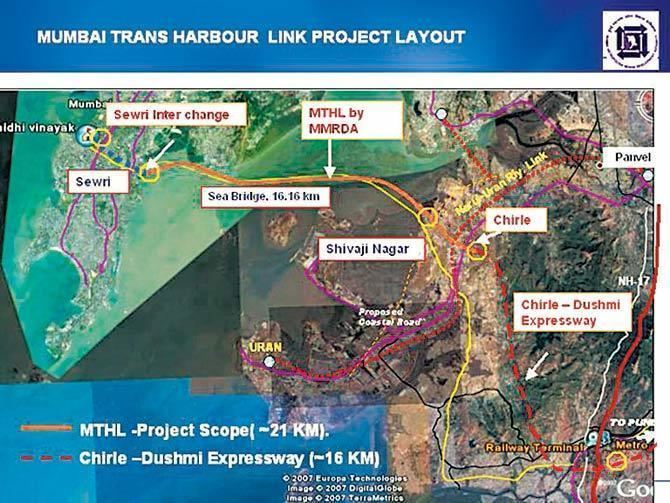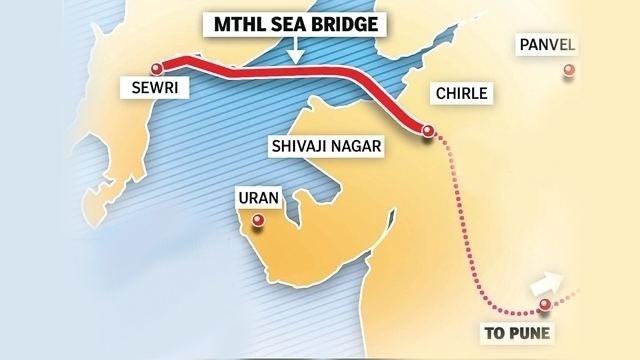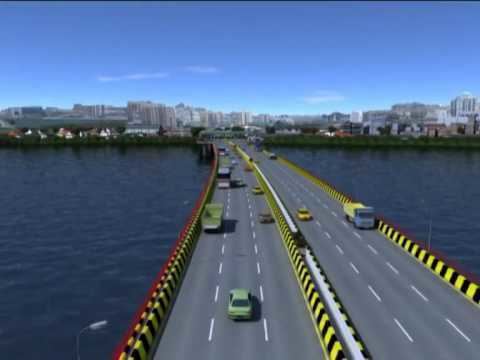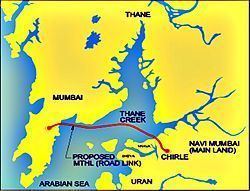Carries Motor vehicles Width 27 metres (89 ft) Opened 2019 Height 25 m | No. of lanes 6 Total length 21,800 m | |
 | ||
Location Mumbai Metropolitan Region Similar Bandra–Worli Sea Link, Vashi Bridge, Airoli Bridge, Seawoods–Darave railway station, Shreepati Arcade | ||
Mumbai trans harbour link mthl longest sea bridge in india
The Mumbai Trans Harbour Link (MTHL), also known as the Sewri-Nhava Sheva Trans Harbour Link, is a proposed 21.8 km, freeway grade road bridge connecting the Indian city of Mumbai with Navi Mumbai, its satellite city. When completed, it would be the longest sea bridge in India. The bridge will begin in Sewri, South Mumbai and cross Thane Creek north of Elephanta Island and will terminate at Chirle village, near Nhava Sheva. The road will be linked to the Mumbai Pune Expressway in the east, and to the proposed Western Freeway in the west. The sea link will contain a 6 lane highway, which will be 27 meters in width, in addition to edge strip and crash barrier.
Contents
- Mumbai trans harbour link mthl longest sea bridge in india
- Sewri nhava sheva mumbai trans harbour link mthl mmrda india s 22 kms longest sea bridge
- History
- First attempt
- Second attempt
- Third attempt
- Fourth attempt
- Switch from PPP to cash contract
- Plan
- Metro lines
- Cost
- Connectors
- Eastern Freeway
- Worli Sewri connector
- Real Estate Projects benefiting from MTHL
- Toll
- References

The project is estimated to cost ₹17,700 crore (US$2.6 billion). The MMRDA plans to award contracts for the project by June 2017, and construction is expected to begin by October 2017.

Sewri nhava sheva mumbai trans harbour link mthl mmrda india s 22 kms longest sea bridge
History

Transportation and traffic planning for Greater Bombay was commissioned to Wilbur Smith and Associates in mid-1962. The firm's report, based on extensive studies conducted over 18 months, was handed over to the Union Ministry of Transport on 19 December 1963. Among other projects, the report proposed the construction of a sea link, known as the Uran Bridge, to connect Mumbai with the mainland. However, Smith was unsure of the link's feasibility. Citing poor traffic expectations in Uran even in 1981, his report advised a more detailed study of this connection and recommended waiting until "the Trans-Thana area develops further and more community services are extended to Uran." In 1973, the Vashi Bridge linking Mankhurd in Mumbai with Vashi in Navi Mumbai was opened.
First attempt

The first concrete attempt to build the sea link was made in 2004, when Infrastructure Leasing & Financial Services (IL&FS) submitted a proposal to implement the project on a build, own, operate and transfer (BOOT) basis. The Maharashtra State Road Development Corporation (MSRDC) also submitted a counter proposal. However, the IL&FS proposal was side-lined by the government, for undisclosed reasons.
Second attempt

Another attempt was made in 2005, when the MSRDC invited bids for the project. But bids submitted by the Ambani brothers was considered to be unrealistic. A consortium of the Anil Dhirubhai Ambani Group company Reliance Energy (REL) and Hyundai Engineering Construction Company quoted a concession period of nine years and 11 months against 75 years quoted by Mukesh Ambani's Sea King Infrastructure (the only other short-listed bidder left, after L&T-Gamon Industries and IFFCO opted out). The REL-Hyundai consortium was initially disqualified at the technical bid stage as Hyundai did not meet the criteria of $200 million net worth specified in the bid document. However, the consortium challenged the disqualification in the Supreme Court, and the Court granted them 90 days to submit their bid that ended on 15 December 2007. The consortium eventually won the bid in February 2008. However, the MSRDC was not sure about viability of the low concession period. The MSRDC felt that the concession periods were "unrealistic" and that both bids "seemed frivolous in nature".
Third attempt
The State Government called for a fresh bids for the project in 2008. However, none of the 13 companies that had shown interest, submitted bids. The media criticized the political feud between the ruling Nationalist Congress Party (NCP) and Congress coalition, as being responsible for slowing "down the pace of Mumbai's development". The city's two infrastructure agencies, the MSRDC and the Mumbai Metropolitan Region Development Authority (MMRDA), under the NCP and Congress respectively, were both planning to construct the MTHL at the same time. The project underwent two failed rounds of tendering under the MSRDC, and was stuck for nearly two years (between 2009 and 2011), before the state government decided to hand over the mandate to MMRDA. Following the decision, the MSRDC asked MMRDA to pay ₹25 crore (US$3.7 million) if it wanted access to any of the studies on the project conducted by the former. After the MMRDA was tasked with executing the MTHL, the MSRDC took up the expansion of the Vashi Bridge by adding six more lanes to ease congestion at the entrance to Navi Mumbai. However, the MMRDA refused the MSRDC's request to allocate funds for the expansion of bridge, as the former believed that the expansion would divert some ridership from the MTHL.
Fourth attempt
The MMRDA appointed Arup Consultancy Engineers and KPMG to conduct the techno-economic feasibility of the MTHL in August 2011. The project will be based on a public-private-partnership model. The project received clearance from Chief Minister Prithviraj Chavan on 22 October 2012. The Times of India described the MTHL's delay as being "symbolic of all that's wrong with infrastructure planning and implementation in Mumbai". The paper also stated that a project being "on the drawing board after more than forty years would be in the realm of fiction in any other country".
The project received environmental clearance from the Ministry of Environment and Forests (MoEF) on 23 October 2012. The Maharashtra State Road Development Corporation (MSRDC) had obtained clearance for the project in March 2005, but the certificate was valid only for 5 years and lapsed due to the delays in the bidding process. The MoEF laid down 11 conditions that the MMRDA had to follow. Some of the conditions were that the MMRDA put up noise barriers, replant five times the number of mangroves destroyed, not carry out dredging or reclamation, use construction equipment with exhaust silencers and work in consultation with the Bombay Natural History Society to minimize the impact on migratory birds. Environmental activists are opposed to the clearance. They point out there was no public hearing following the second application for environmental clearance. They believe that the sea link is not allowed as per the new Coastal Regulation Zone (CRZ) notification of 2011. Activists also claim that the sea link would damage a huge mudflat and mangrove tract towards Sewri and Nhava which is a habitat for migratory birds like flamingos. MMRDA plans to construct sound barriers on the bridge so that it does not affect the flamingo habitat at Sewri. The Department of Atomic Energy (DAE) has directed MMRDA to construct a six-km long view barrier to cut the view of Bhabha Atomic Research Centre (BARC). The MTHL received coastal regulation zone clearance from the MoEF on 19 July 2013.
On 31 October 2012, the Department of Economic Affairs (DEA) granted in-principle approval for the MTHL. The DEA recommended granting ₹1,920 crore (US$290 million) with a concession period of 35 years for the project. In the first meeting, between MMRDA and DEA officials in September 2012, the ministry had asked the authority to treat the sea link as a road and reduce the proposed concession period from 45 years to 30 years. They also expected an internal rate of return of 15% for the project. However, the MMRDA wanted a higher rate as they claimed the project was very risky. An internal rate of return of 17% was agreed upon. The termination clause in the concession agreement comes into effect after 30 years into the concession period. The MMRDA can invoke the clause based on certain conditions such as the capacity being higher than expected. The conditions will be reviewed in the 20th year of the concession agreement. The DEA is the first tier of the three-tier clearance process to get viability gap funding (VGF) for the project. The project must also receive approval from an Empowered Committee and finally from the Finance Minister. On 9 November 2012, the State Government issued a state-support agreement and a toll notification for the project. The empowered committee approved VGF for MTHL on 12 December 2012. Finance Minister P. Chidambaram cleared the project on 18 January 2013.
The Jawaharlal Nehru Port Trust (JNPT) asked the MMRDA to build the MTHL at a height of 51 metres, instead of the proposed 25 metres, for a span of 300 metres to accommodate its expansion plans for its fifth container terminal and to allow safe passage of bigger vessels. MMRDA expressed that a height of 51 metres would not be feasible as it would have a huge impact on the cost. However, MMRDA officials expressed willingness to raise the height of the bridge to 31–35 metres. On 8 January 2012, Minister of State for Shipping and MP from South Mumbai, Milind Deora told reporters that JNPT would issue a No Objection Certificate to the State Government to go ahead with the project.
In May 2012, the MMRDA shortlisted five consortia for the project: Cintra-SOMA-Srei, Gammon Infrastructure Projects Ltd.-OHL, Concessions-G.S. Engineering, GMR Infrastructure-L&T Ltd.-Samsung C&T Corpn., IRB Infrastructure Developers Ltd.-Hyundai, and Tata Realty and Infrastructure Ltd.-Autostrade Indian Infrastructure Development Pvt. Ltd.-Vinci Concessions Development V Pte Ltd. None of the five shortlisted firms bid for the project by the deadline, which was extended August 5. IRB-Hyundai had announced their withdrawal from the bidding process, on 31 July 2013, citing "the government's apathy and unfriendly attitude towards investors wanting to develop capital-intensive infra projects". Following the failure of the tender, the MMRDA decided to abandon the PPP model and instead implement the project on cash contract basis.
In January 2013, the Central Government had sanctioned ₹1,920 crore (US$290 million), which was 20% of the project cost at the time, in viability gap for the MTHL. Under the public private partnership (PPP) basis that the project was proposed to be implemented in, the State Government would also contribute the same amount as the Centre, while the remaining 60% would have been borne by the developer who won the bid. The concession period would have been 35 years, which included the time-frame of 5 years for the construction. However, the consortia shortlisted for the project were concerned that 15-20% of the projected traffic for the MTHL, was due to the proposed Navi Mumbai airport, which was heavily delayed. The MMRDA added provision for a shortfall loan to be made available from the central government if traffic is 20% under the estimate.
Switch from PPP to cash-contract
The MMRDA decided to scrap the PPP model for the project in August 2013, and instead execute it on a cash-contract basis. Subsequently, the Japan International Cooperation Agency (JICA) expressed interest in providing funds for the project. In January 2014, Ashwini Bhide, MMRDA additional metropolitan commissioner, told The Indian Express that the state government had sent a formal proposal to the DEA for its approval to get funds from JICA. In June 2014, Business Line reported that Jawaharlal Nehru Port Trust authorities had agreed to pick up a stake in the project.
The project ran into a major hurdle in April 2015, when the forest advisory committee (FAC) of the MoEF withheld its clearance for the project stating that it affects "existing mangroves as well as the flamingo population". The project requires clearance from the Ministry as it will affect 38 hectares of protected mangrove forests and 8.8 hectares of forest land on the Navi Mumbai end. The sea link's starting point poses a threat to an estimated 20,000-30,000 lesser and greater flamingos and the mangrove habitat. The Sewri mudflats are home to 150 species of birds species, and is listed as an "Important Bird Area". The FAC instructed the state government to submit a study report on the project's impact on the flamingo population, and recommended that the government seek the help of either the Bombay Natural History Society (BNHS) or the Wildlife Institute of India, Dehradun to conduct the study. The cost of the study will be borne by the MMRDA, which will also have to come with safeguards to cause the least disturbance to the flamingos at Sewri.
On 17 April 2015, Union Minister of Road Transport and Highways Nitin Gadkari stated that he favoured the construction of a submarine tunnel instead of a sea link. Gadkari stated that the tunnel would cost less than a bridge (citing the example of the tunnel between Rotterdam and Belgium), and would also be aesthetically preferable as a sea link would obstruct the city's coastline. However, Gadkari clarified that the Union Government would accept the final decision made by the State Government on this matter. Following a visit to China, Maharashtra Chief Minister Devendra Fadnavis announced on 20 May 2015, that the China Communications Construction Company (CCCC) had expressed interest in the MTHL project. According to Fadnavis, the CCCC will complete the project within 3–4 years of being appointed and will also provide 2% concessional funding for the project.
In November 2015, the project was cleared by the Maharashtra Coastal Zone Management Authority (MCZMA). In January 2016, the Forest Advisory Committee (FAC) granted forest clearance, and the Experts' Appraisal Committee (EAC) attached to the MoEF granted CRZ clearance to the project. The CRZ came with a rider requiring the MMRDA to spend at least ₹335 crore towards an "environment management programme". In the same month, Fadnavis announced that the project had received all required clearances.
In February 2016, JICA agreed to loan 80% of the total cost of the project to the State Government at an annual interest rate of 1-1.4%. The MMRDA will bear 1.2% of the project cost, and the remaining amount will be borne by the State Government. As JICA was unwilling to loan directly to the state Government, the Union Government stood as a guarantor of the loan. As part of the agreement between JICA and the State Government, 2 rescue lanes will be added to the proposed plan for the MTHL, and a 4 km stretch of the bridge will be constructed as a steel-only structure instead of previous plan to build a cement and concrete bridge. The use of steel on this stretch will raise the project cost by ₹4000 crores. JICA formally approved the funding agreement on 9 May 2016, and the MMRDA began the bidding process the following day. The MMRDA invited request for qualifications (RFQ) for civil construction of three packages - a 10.38 km long bridge section across the Mumbai Bay and Sewri interchange (₹ 6,600 crore), a 7.807 km long bridge section across Mumbai Bay and Shivaji Nagar inter change (₹ 4,900 crore) and a 3.613 km long viaduct including interchanges at SH 52, SH54 and NH 4B near Chirle, Navi Mumbai. The MMRDA received 11 pre-qualification bids each for the first and second package, and 17 bids for the third package. The agency stated that a single party would not be awarded the first and second packages together, although any other combination of the three packages would be permitted.
The MMRDA appointed a consortium formed by AECOM Asia Co Ltd, Dar Al-Handsah and TY Lin International as the general consultant for the project on 26 November 2016. According to UPS Madan, Metropolitan Commissioner, MMRDA, "The General Consultants appointed for the MTHL project will engage in various activities such as to help MMRDA organise pre-bid meetings, examine bid documents, secure various permissions from government, semi-government, examine concept designs, monitor construction of the project and ensure quality of the work among other things."
Prime Minister Narendra Modi laid the foundation stone for the project on 24 December 2016. After evaluating the bids, in January 2017, the MMRDA shortlisted a total of 29 contractors for the three packages and floated tenders for the request for proposal (RFP) stage, the final stage of the bidding process. The agency fixed 5 April 2017 as the final date for submissions of the RFP bids.
The MMRDA plans to award contracts for the project by June 2017. Construction is expected to begin by October 2017, and complete within 5 years.
Plan
16.5 km of the MTHL will be in the sea and 5.5 km on land. The MTHL will be constructed in three sections:
- A 10.38 km-long bridge, spanning across Thane Creek and Sewri Interchange.
- A 7.807 km-long bridge portion across Thane Creek and the Shivaji Nagar interchange
- A 3.613 km-long viaduct and interchanges that connect State Highways 52 and 54 and National Highway 4B at Chirle, Navi Mumbai.
The project requires 130 hectares of land. The City and Industrial Development Corporation (CIDCO) contributed 88 hectares and the Mumbai Port Trust handed over 13 hectares. The remaining land is privately owned. According to MMRDA officials, land owners will be given the same compensation package as that given in the Navi Mumbai International Airport project.
In October 2016, the MMRDA agreed to pay MbPT a total of ₹1000 crores in instalments over the course of 30 years as rent for using the MbPT's land for construction of ramps for the MTHL on the Mumbai side.
The MMRDA utilized a drone to carry out survey work for the MTHL. The drones were fitted with 360 degrees camera that provide up to 3 millimeter accuracy. The aerial survey takes less time than a regular survey, achieves greater accuracy and helps protect against false claims for compensation.
Metro lines
Initially, there were plans to have a dual metro line below the road lanes on the bridge. The metro Line was to be extended to the proposed Navi Mumbai International Airport and connected to the proposed Ranjanpada-Sewood-Kharkopar corridor of the Navi Mumbai Metro and the proposed Sewri-Prabhadevi corridor of the Mumbai Metro. However, the MMRDA scrapped plans for the metro line in 2012, and decided to build only a road bridge. A senior MMRDA official stated, "A detailed study has revealed that laying the foundation for the bridge with provisions for two metro lanes would hike costs instead of save money. Hence, it will be feasible to have a separate bridge for the metro in the future." Another reason given was that the Navi Mumbai International Airport and Sewri-Prabhadevi corridor of the Mumbai Metro were still a long way from completion.
Cost
The cost of the MTHL has increased several times. In 2005, the cost of the project was estimated at ₹4,000 crore (equivalent to ₹95 billion or US$1.4 billion in 2016). The cost was revised to ₹6000 crore in 2008. It was then increased to ₹8800 crore in November 2011 and to ₹9360 crore in August 2012. The MMRDA re-evaluated the cost project as about ₹11,000 crore (US$1.6 billion) at 2014 prices. In 2016, the project cost was estimated at ₹17,700 crores, which includes ₹70 crore compensation to fishermen, ₹45 crore for installing noise barriers after opening the sea link, a ₹25 crore deposit as seed money to mangrove fund, another ₹25 crore for a compensatory mangrove restoration plan, and a mandatory expenditure of at least ₹335 crore for an "environment management programme". 80% of the total project funding will be obtained through a loan from the JICA.
Connectors
Although three connectors were proposed, the MMRDA plans to only construct the Worli-Sewri connector initially. According to Ashwini Bhide, additional metropolitan commissioner of MMRDA, "To construct the other ramps, the alignment will pass through BDD chawls. Redevelopment of BDD chawls is being considered by the state, so we will take up work on the other ramps at a later date."
Eastern Freeway
The Eastern Freeway is a 16.9 km long controlled-access freeway, that connects P D'Mello Road in South Mumbai to the Eastern Express Highway (EEH) at Ghatkopar.
Worli – Sewri connector
The Sewri – Worli connector would connect the Bandra-Worli Sea Link and the Mumbai Trans Harbour Link. A new bridge between Worli and Sewri is scheduled for completion by 2017. It will be 4.5 km long The bridge will be cable-stayed. The project is expected to cost ₹490 crore (US$73 million), and be completed in four years.
The MMRDA received bids from 5 companies to construct the Worli – Sewri connector. They were Simplex Infrastructures Ltd, Larsen & Toubro, Hindustan Construction Company, Gammon India and the National Construction Company (NCC). Simplex Infrastructures Ltd quoted the lowest bid (nearly 16-17% below the estimated cost of the project), followed by Larsen & Toubro (14% below the reserve price). In April 2016, DNA reported that the project had been cancelled, after previously being put "on hold" in 2015. No budgetary allocation was made for the project in the 2015-16 fiscal, and the MMRDA has no future plans to construct the connector.
Real Estate Projects benefiting from MTHL
MTHL will connect Wadala / Dadar East with Navi Mumbai. This is going to significantly boost the Real Estate appreciation in both the areas. Wadala, close to Dadar East is notified as one of the top investment destination by Knight Frank. Investment in large under-construction projects like Island City centre (ICC) from Bombay Realty (Wadia Group) , with delivery timelines closer to planned construction of MTHL will be one of the benefactors of the development of MTHL
Toll
In 2012, the MMRDA proposed tolls for the MTHL as ₹175 for cars, ₹265 for light commercial vehicles, ₹525 for buses and trucks and ₹790 for heavy axle vehicles. JICA, the primary source of funding the project, proposed higher tolls in 2016. In September 2016, The Indian Express reported that the toll for the MTHL was likely to remain the same as the figures proposed in 2012, although the estimated cost of the project had doubled since that year.
